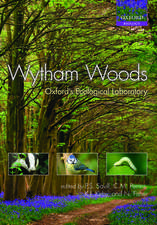The Biology of Hagfishes
Editat de Jørgen Mørup Jørgensen, J. P. Lomholt, R.E. Weber, H. Malteen Limba Engleză Paperback – 28 oct 2012
Preț: 1130.27 lei
Preț vechi: 1378.38 lei
-18% Nou
Puncte Express: 1695
Preț estimativ în valută:
216.28€ • 235.67$ • 182.24£
216.28€ • 235.67$ • 182.24£
Carte tipărită la comandă
Livrare economică 23 aprilie-07 mai
Preluare comenzi: 021 569.72.76
Specificații
ISBN-13: 9789401064651
ISBN-10: 9401064652
Pagini: 604
Ilustrații: XIX, 578 p.
Dimensiuni: 189 x 246 x 32 mm
Greutate: 1.06 kg
Ediția:1998
Editura: SPRINGER NETHERLANDS
Colecția Springer
Locul publicării:Dordrecht, Netherlands
ISBN-10: 9401064652
Pagini: 604
Ilustrații: XIX, 578 p.
Dimensiuni: 189 x 246 x 32 mm
Greutate: 1.06 kg
Ediția:1998
Editura: SPRINGER NETHERLANDS
Colecția Springer
Locul publicării:Dordrecht, Netherlands
Public țintă
ResearchCuprins
One Evolution, Taxonomy and Ecology.- 1 Relationships of living and fossil hagfishes.- 2 Conodonts: a sister group to hagfishes?.- 3 Hagfish systematics.- 4 Asian hagfishes and their fisheries biology.- 5 The ecology of hagfishes.- Two Development and Pathology.- 6 Chromatin diminution and chromosome elimination in hagfishes.- 7 The tumour pathology of Myxine glutinosa.- Three The Integument and Associated Glands.- 8 Hagfish skin and slime glands.- 9 The dermis.- Four Supporting Tissues.- 10 The notochord.- 11 Hagfish cartilage.- Five The Muscular System.- 12 The skeletal muscle fibre types of Myxine glutinosa.- Six The Respiratory System.- 13 The gills of hagfishes.- 14 Ventilation and gas exchange.- Seven The Cardiovascular System.- 15 Cardiovascular function in hagfishes.- 16 The sinus system of hagfishes — lymphatic or secondary circulatory system?.- 17 Dermal capillaries.- Eight The blood and Immune System.- 18 Hagfish blood cells and their formation.- 19 Volume regulation in red blood cells.- 20 Transport of bicarbonate, other ions and substrates across the red blood cell membrane of hagfishes.- 21 Hagfish haemoglobins.- 22 The hagfish immune system.- Nine The Uro-genital System.- 23 The hagfish kidney as a model to study renal physiology and toxicology.- 24 An analysis of the function of the glomeruli of the hagfish mesonephric kidney.- 25 Gonads and reproduction in hagfishes.- Ten The Endocrine System.- 26 The endocrine system of hagfishes.- 27 The control of catecholamine secretion in hagfishes.- Eleven The Nervous System.- 28 Ontogeny of the head and nervous system of myxinoids.- 29 The central nervous system of hagfishes.- 30 The autonomic nervous system and chromaffin tissue in hagfishes.- Twelve The Sensory Organs.- 31 Skin sensory organs in the Atlantichagfish Myxine glutinosa.- 32 Cutaneous exteroreceptors and their innervation in hagfishes.- 33 The olfactory system of hagfishes.- 34 The eyes of hagfishes.- 35 Structure of the hagfish inner ear.- 36 Physiology of the inner ear.
Recenzii
'... a mine of information on many aspects of hagfish biology. It succeeds because of its breadth and because of the consistent approach of the authors... highly recommended as a summary of current knowledge... belongs in every serious library and on the shelf of comparative vertebrate biologists.'
Copeia, 3 (2000)
Copeia, 3 (2000)












